I've had a few followers ask me my thoughts on the Sturgis study. It's gone viral because it tells a story the media likes ("bad" people got COVID for doing "bad" things). But the science is...dubious. It's honestly not even science, nor done by actual scientists. Quick thoughts: https://twitter.com/nycjim/status/1303308619035836419
Note that you can read the study yourself here: http://ftp.iza.org/dp13670.pdf
It starts out by tracking cellphone data to show a huge influx of people to this South Dakota County, a huge spike in people at restaurants/bars/etc, and a rise in COVID cases in that county.
Fair enough.
It starts out by tracking cellphone data to show a huge influx of people to this South Dakota County, a huge spike in people at restaurants/bars/etc, and a rise in COVID cases in that county.
Fair enough.
Then, because this was done by economists rather than scientists they apply an elaborate statistical model (invoking things like RAINFALL). It's unclear how it gets used, but they end up plotting COVID cases in counties as a function of their relative population inflow to Sturgis
This is bizarre data for two reasons. One, they're claiming cases are largely rising nationwide during a period when, in fact, COVID-19 cases have been dropping. They are also claiming that cases start rising within the first 3 days of the start of the event, which is impossible.
Even if we somehow assume most people got it the first two days of the event, and then they got home two days later, and then got tested their first day back home, most tests take 5-7 days to return, so you shouldn't see any spike for at least 10 days after the opening of Sturgis

 Read on Twitter
Read on Twitter



